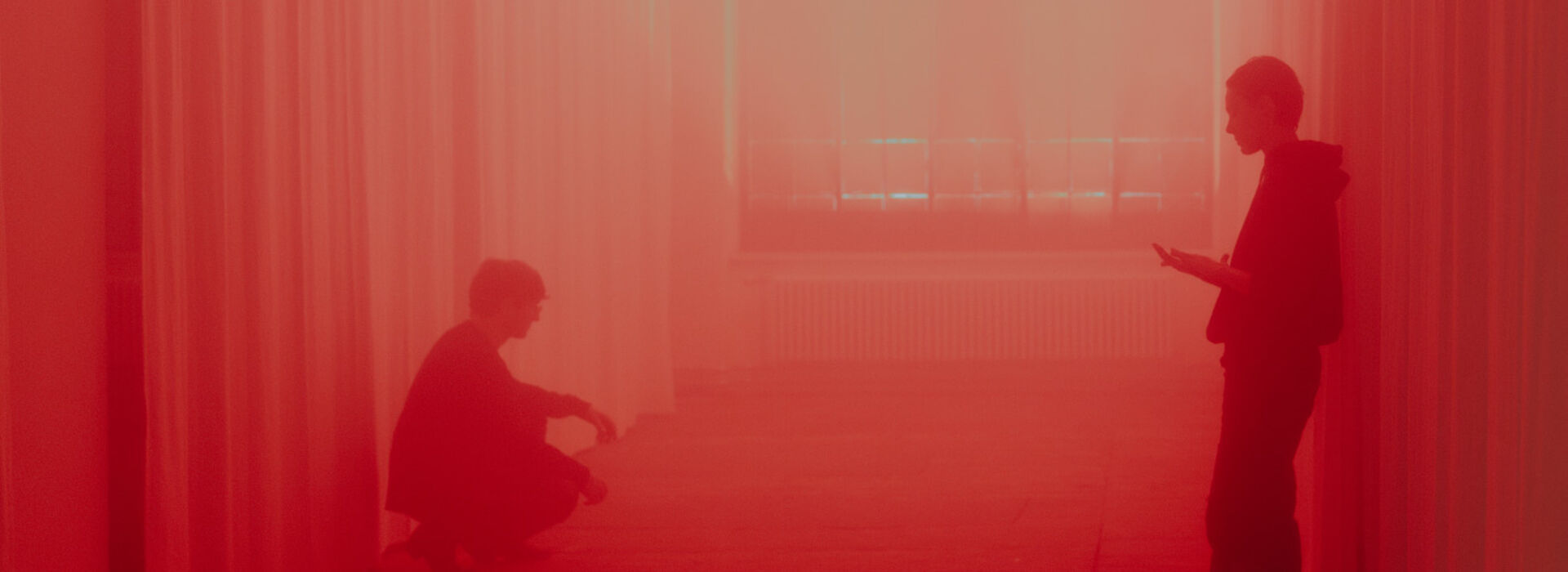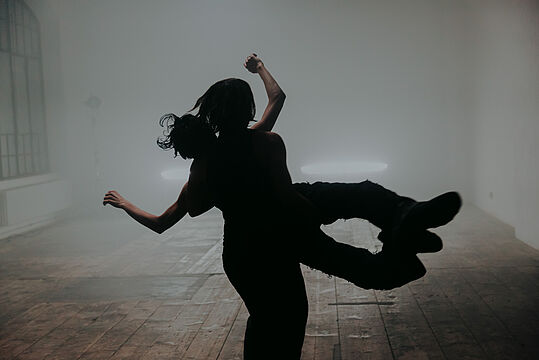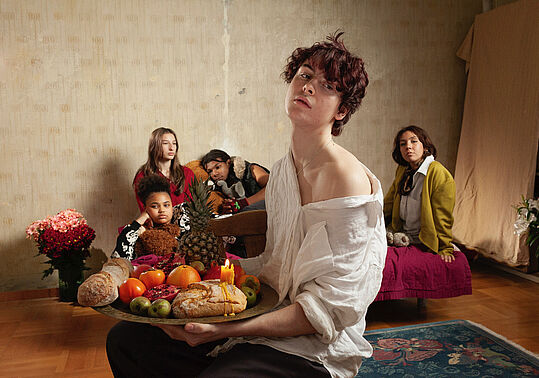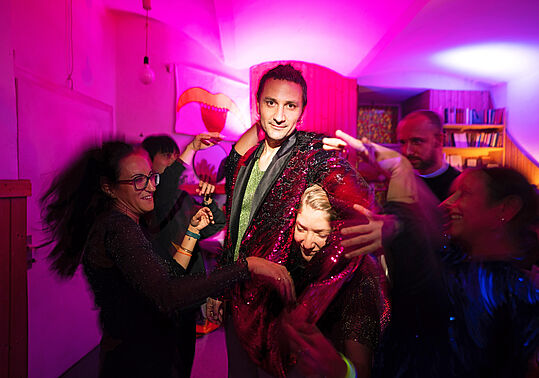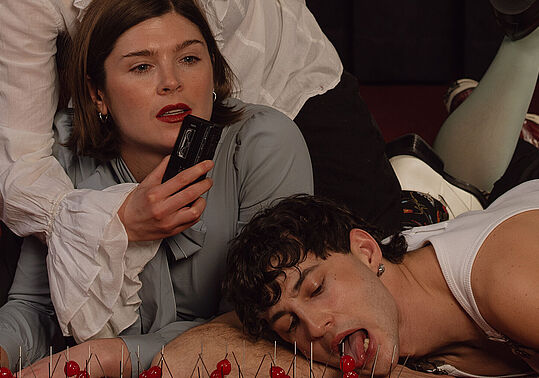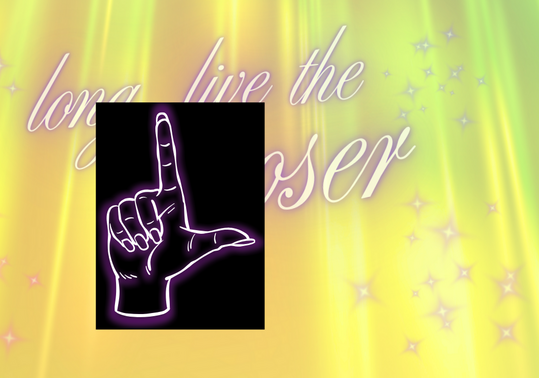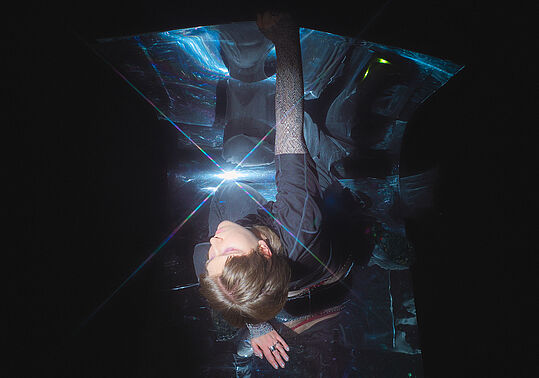Exploring the Sacred through Movement
What inspired you to investigate the relations between presence, touch and sight and how do these ideas find their way into the movement vocabulary and performance choices in "Latente"?
It started during my master’s study, which unfolded through the time of the latest pandemic and social distancing. During this period I gave the time to myself to stop and observe why I do things the way I do them.
By observing how I gaze at the world around me and noticing all the different facets that the somatic experience of seeing entails, I started to write scores that encourage a way of seeing that is tactile. This means thinking of and sensing the eye as an organ of touch. At the same time I was trying to navigate the relation between dance forms and their somatic experience and how the image/representation that we have in mind of such forms, contributes to a specific sense of self in the specific moment we embody the form.
So from experimenting with gaze I started to gaze at things and images too as if I could touch them and allow this tactile information to get into my body. This practice generates a sense of presence that feels like a constant longing for images that touch my tactile body even if I am seeing them with my eyes.
In your work, the Medieval period acts as a lens through which you examine the present. What fascinates you about this era, and in what ways does it influence the choreography in "Latente"?
Part of my research delved into the cultural history of touch and and also more in general into beliefs about the inner body and body concepts in pre-modern medicine time.
In the book The deepest sense, A Cultural history of touch, Constance Classen extensively dives into the medieval time and looks at how the sense of touch was part of medieval culture. Feudal life implied proximity, art which at the time was mainly religious was meant to be touched, a handshake or a kiss had symbolic importance and was considered a sealed deal, something to trust and so on.
Medieval time also saw the transition from spoken prayers to chanted prayers as the firm believe that armonizing words would bring one closer to the divine became concrete.
During the process I listened to many medieval music compositions, sacred and profane.
We then practiced as choir with the memory of such music, looking for harmonies and singing with each other in order to touch eachother and the space. The choir is there to evoke a sense of devotion and a wish to extract, maybe reappropriate, what of the imposed religious liturgy, can still help us finding collective power and resist.
Besides keeping a strong relation to medieval music, Latente relates to the middle ages also for how it has been defined from Enlightment thinkers (whose culture completely discredited touch as a barbaric sense): the Dark Ages.
This darkness, or perhaps opacity of the present time, might require a shift within the hierarchy of the senses and question the hegemony of the visual sense and the idea of transparency.
The medieval time initially penetrated my project through a linguistic association that departs from perceiving the present time as an in-between.
Mark Fisher drew parallels between the cultural and social dynamics of the late capitalist present. He suggests that, even though we live in this hyper-technological world of apparent constant progress, there’s this strange feeling that we’ve hit a wall when it comes to imagining the future. We’re kind of stuck in a loop, where capitalism feels so inevitable that we can’t even picture anything beyond it. It’s like we’re experiencing our own kind of cultural stasis, just like people in the Middle Ages were stuck with the idea that feudalism and the church were permanent, unchangeable realities.
Yet at one point the change was there. But it appears to me, within the knowledge I have, that Renaissance, while breaking from the close past, was fueled by a Nostalgia for classical antiquity and by the wish to revive that glorious time that Renaissance people did not even experience. So they could not even miss it.
The past haunting us, our contemporary Nostalgia pandemic, especially when the world changes too fast and undergoes deep doom crises, is perhaps the most politically instrumentalized feeling today.
Touch in "Latente" takes on a sacred quality, almost like a form of worship or meditation. How did you approach embodying this sense of devotion during your creative process?
The piece unfolds in a fictionalized space of cult, in which what we worship is tactility itself. Touch, the sense on which all senses rely, is here not only what the skin experiences. It entails the capability to be emotionally touched but it extends also to that inner body feeling through which you are able to grasp yourself and say that you exist.
Referring to catholic religion as one of the ghosts of my life, we tried throughout the piece to extract the potency of sacral representation to worship something different than a god. What we worship is maybe something we see in danger or under threat. Something we want to protect and keep track of while everything else changes. What this thing to protect and to cherish is, is different to all of us. And in an exercise of speculation on a future made of disembodiment, the piece becomes a liturgy in which each part worships touch in a different ways and through different means.
"Latente" brings up the coexistence of physical bodies and ghostly presences. How do you explore this balance between the tangible and the intangible in your choreography?
Learned body behaviour, dance technique and basically all we do with our bodies, is a surrogate of things we saw from others and embodied our own way. In the case of dance techniques and the way they colonize the body , it is not uncommon how dancers try to unlearn and free themselves from dance patterns. During the process we tapped into our dance and embodied archives pulled out what, even if hidden or latent, remains active into our body memory. Without realizing we carry an infinite amount of bodies within ourselves. So we worked on letting them out in the room and literally watched them dancing, singing, performing. Those dancers we imagine to be surrounded by and that at times incarnate into our bodies, are versions of ourselves, people we saw or people we only have historical knowledge about.
The way this manifests in the choreography varies in the different parts of the performance and the ghosts accompanying us and the audience are not only bodies but also images, icones, smells, sounds and concepts. We mainly worked with ghosts by which we feel haunted.
Zu allen Artikeln

